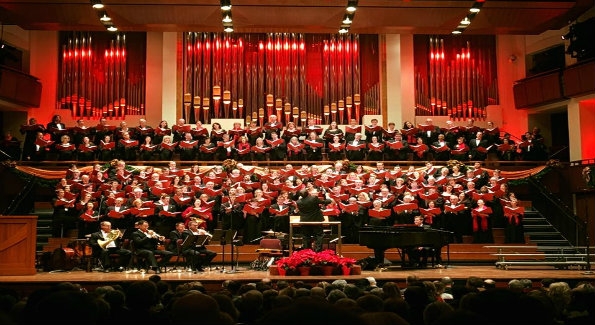Maestro Scott Tucker and the Choral Arts Chorus was joined by local gospel artist Ralph Herndon for an inspirational evening of traditional holiday favorites and rousing gospel standards.
By Patrick D. McCoy

Maestro Scott Tucker conducts the Choral Arts Chorus in its annual Christmas concert at The Kennedy Center. (Photo Credit: John Arundel)
It is always amazing during the holiday season to attend many concerts in The Kennedy Center Concert Hall and still be able to experience something uniquely different. This year, the Choral Arts Society of Washington presented its annual program themed “A Choral Arts Christmas” with the welcomed addition of gospel artist Ralph Herndon. A favorite guest artist of the late Norman Scribner, Herndon usually would be featured during the annual Martin Luther King celebration. It was a lovely contrast to hear his unique touch added to this festive choral celebration.
Before the concert, the audience was treated to an extended prelude of holiday favorites performed by the brass ensemble.
Opening with the festive anthem “Welcome All Wonders” by Richard Wayne Dirksen, the piece provided the perfect concert opener. Soaring brass and full organ punctuated by the timpani was the perfect vehicle for the majestic voices of the Choral Arts Chorus conducted by Scott Tucker. The contrasting middle section of the piece highlighted the chorus’ trademark warm, lush sound and beautifully sung phrases. A recap of the anthem’s opening brought the selection its close, with the rousing approval of the full audience.
Three settings based on the melody of the beautiful chorale “How Brightly Shines the Morning Star” continued in the next section. Johann Sebastian Bach’s expansive work for chorus, brass and organ was marked by a lilting joy and set the stage for the two contrasting settings that followed. Organist William Neil showed off the whimsical, light organ stops of the Casavant organ in the famous chorale setting for organ. Closing out this wonderful triptych was Peter Cornelius’ “We Three Kings” which featured baritone Brandon Straub singing with a voice of warmth and clarity wafting above the Choral Arts Chorus.
A theme of light was present in the next section of the program. One of several transcendent moments of the program was the rendering of Morten Lauridsen’s “O Nata Lux.” The a cappella voices of the Choral Arts against the backdrop of candlelight illumined chorus created the perfect holiday vignette.
One of the fascinating aspects of the holiday for many is the presence of children. The Choral Arts Youth Chorus offered two selections under the direction of Brandon Straub. The ethereal “Lux Aurumque” by Eric Whitacre continued the theme of light. Full of rich dissonances and harmonic sonorities the youthful voices brought forth an innocent quality that hearkened back to childhood.
As the choir launched into the famous “Carol of the Bells” the audience was audibly delighted by the inclusion of the holiday favorite.
Ralph Herndon continued the theme with the gospel favorite “Jesus, the Light of the World.” At the piano, Herndon lent his soulful touch at the piano interpolating his rousing solos on the verses with the Choral Arts Chorus.
A spark of joy seemed to spread throughout the hall as members of the audience clapped and swayed with a new found permission. “Give Me a Star” by Edwin Hawkins was certainly another rousing crowd pleaser, filling the hall with holiday exuberance.
Under the gracious patronage of His Excellency, the Ambassador of Switzerland and Mrs. Anita Dahinden-the concert featured several Swiss carols which included a beautiful setting of the traditional Romansch carol “S’Allegra Pur Gerusalem” to the familiar tune of “Good Christians, All Rejoice and Sing.
” Rounding out the program was the singing of traditional carols with the audience. From where we were seated, the innocent singing voice of a little girl seated in front of us (Orchestra DD) soared on the stanzas of the traditional carol “Silent Night.
” Providing the perfect segue, the chorus continued into the “Ave Maria” by Franz Biebl. Sung unaccompanied, voices sang with remarkable contrasting dynamics, marked by lyrical long phrases.
Evoking the reverence and awe of the season, the work grew to a soaring conclusion.
Bringing the inspiring evening to a close was Julian Wachner‘s ebullient setting of the traditional carol “Joy to the World.”
